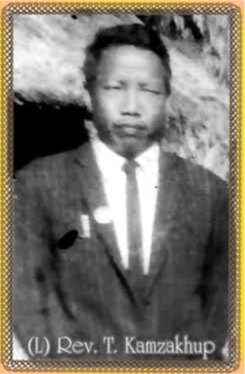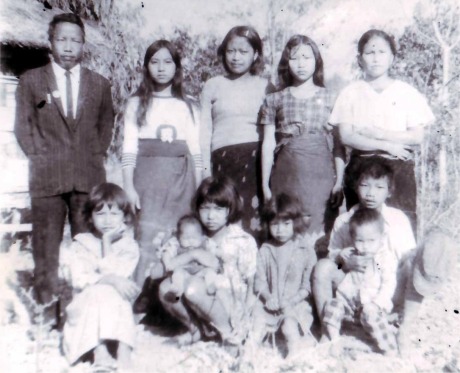Papa
Late Rev. T. Kamzakhup Zou
(1930 – 1979)

Late Rev. Kamzakhup
My beloved papa is the eldest son of my grand pa, Pu Awnkhawm. He was born in 1030 at T. Singtam Village, Churachandpur District, Manipur. When he was only 20 years old, he become one of the founding Executive Member of Simte Christian Association and later Evangelical Christian Association. He shifted to Daijang Village searching for a better livelihood when he was about 30 years old.
In 1950 February 20, he become the Founding General Secretary of the Jou Christian Association (JCA) at Daijang Village. This JCA’s Golden Jubilee was celebrated on 20th February 2004 at Zomi Colony under the conductorship of his youngest son.
On May 21, 1957 he become an evangelist. In 1959 he married my lovely mother, Niengzadim. He finish G. Th. under The Aizawl Theological College in 1973, He was ordained as a Pastor in 1978.
Not long after his ordination as a pastor, on May 3, 1979 he left this suffering world for his heavenly abode.
Sons & Daughters
- Niengkhanman w/o B. Chinzalam (Daijang, The Bethlehem of the Zos
- Dimneikim w/o Zamkhogin (Laphelpat, Imphal)
- T. Khamzahau (Died) (Unmarried)
- Vungsuonching w/o Lielien Gangte (Langol, Imphal)
- Lamneichiin w/o William Das Fransis (Madanriting, Shillong)
- Zamlunmang h/o Irene Mary (Delhi)
- Tunu Naomi Haumuonching (The most sweetest)

Famely Foto
—————————————————-
Ode to my father
Ka Zuo It
(MY BELOVED FATHER)
Senpa’n momnou zuo mel mu lou,
Tunnu’n anglai nau bang hing pom e;
Lai ah na sa’ng sangga zuo pomkha lou,
Zal mang laukha’n ka sieng hing kawm ve aw;
Sangga momnou in lung zuon man in,
Vaimang siemsil tung a tutkhawl,
Tong kup theilou na sahmel vel vel veng e.
Zuo aw tuong nung na’ng sia apa’n,
Na min thei bang lou lou veng e;
Lou chim la’ng e, pienna ka zuo aw,
Tuong nung na’ng sie apa’n;
Vangkhuo limlien sausuon dai in damta e,
Mim bang pienna ka it tuunnu toh;
Tuonglam sa bang vaimaw ung e.
Pienna tuun-le-laizom teng toh,
Sangga genlieng siel siel ding a;
Zuo aw tuong nung na’ng sie a hiei?
Zuo aw tuong nung na’ng sieh apa’n,
Sen puseite’n sen momnou paibang pom vang;
Sien ni-nu toh sawn momnou sangga paibang pom vang chi e.
Sen puseite’n sawn momnou pai bang pom e,
Pai bang pom in, sawn momnou siel bang sangga kile in;
Tuun lungzuong leh laizom teng nun in nuom e.
Tuun lungzuong mu bang ka ngai ma’n,
Von momnou in mal bang kou kou ing e;
Tuun lungzuong simlei-le-thangvan kal ah mubang laam in,
Tuonglam zawtlou, India khopi Delhi tuol ah nga bang leng ta e.
Sangga momnou kiil bang khang in,
Tuun lungzuong leh deizawn angkawi lianu toh;
Saunuom sungah hou lung kum e,
Kum chimlou e, nuichiem leel in;
Nunnuom laituol leeng leeng ung e.
Written by Tungnung, Zamlunmang Zou
(Youngest son of Late T. Kamzkhup Zou)
—————————————
Local Church Movement under JCA le by (L) T. Kamzakhup Zou
The new Zou Christian converts joined different dialectal groups, especially the Paite and Thado Christian groups. To stem the tide of this social crisis, some intelligent Zou youngsters organised on 20 Feb. 1954 the first Zou Conference at Daizang village. The JCA (Jou Christian Association) conference deliberated on issues related to the social and religious life of the community. The JCA agenda was not exclusively religious. Besides Pu Kamzakhup, the pillars of the JCA in its initial days were the three educated figures of Pu Thawng Hang, Pu Sem Kho Pau, and Pu Kai Za Kham. The triple leaders were still students at Imphal at that point of time, and they were entrusted with the task of drafting a ‘Constitution’ for JCA, which was finally adopted at the Daizang assembly.
However, there seemed to be a lot of spade work before the JCA assembly could be convened on 20 February 1954. A preliminary meeting was held at Tuaitengphai village on the occasion of ‘Haitha’ (First Fruit) festival in which the villages of Daizang, Boh Lui and Khianglam were scheduled to participate; but the last two did not turned up. A migrant from Mawngawn village, Pu KamzaKhup became a resident of Daizang village since 1951. His arrival in Daizang made that village a hub of Christian activities in the 1950s. Despite his humble occupation as a peasant, Kamzakhup appeared to be a born reformer. He was consumed with zeal to initiate a local church movement among his tribespeople – the Zou dialect community. When he moved into Daizang in 1951, there were reportedly just four Christian villages out of the total sixty-six Zou villages. Enthused with the challenge of initiating a new movement, this layman would share his social vision with his confidant named Thawngzakhup. Both jointly managed to bring the village elders for a public discussion at Tuaitengphai in 1952. But nothing concrete came out of the meeting. Still undaunted, Pu Kamzakhup continued his campaign for a cause close to his heart. The reformist duo (Kamzakhup and Thawngzakhup) would excitedly talk about their future project even while working in the wet rice field. The first important outcome of all those untiring discussion and persuasion was the staging of a partially successful joint meeting between Daizang and Tuaitengphai in 1953. That, in turn, provided a solid foundation for a more spectacular success. It actually became a prelude to the historic JCA meeting at Daizang on 20 February 1954 (see JCA Minute Book).
Finally, one may wonder: where did Pu Kamzakhup catch his Gospel fire? The clue lies in his early residence at Mawngawn village. The social environment of Mawngawn in the 1940s – swept by waves of Christian conversion – must have contributed significantly to the making of this Zou social reformer.
![Reblog this post [with Zemanta]](https://i0.wp.com/img.zemanta.com/reblog_e.png)


Comments»
No comments yet — be the first.